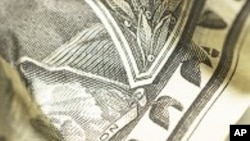<!-- IMAGE -->
The longest and deepest U.S. economic recession of the post-World War II era is over, according to government data released Thursday.
After four consecutive quarters of contraction, the U.S. economy grew at a 3.5 percent annual rate from July through September. The figure, released by the Commerce Department, showed the most robust expansion in two years.
Economists, like Kathleen Stephansen at Connecticut-based Aladdin Capital Holdings, hailed the news. "Indeed, the recovery is in place. This is a good start. It is a little bit stronger than what the consensus [expectation] was," she said, Stephansen was speaking on Bloomberg television.
Fueling the economic growth were jumps in spending on large manufactured goods and housing. Both of those categories benefited from significant government subsidies for the purchase of fuel-efficient vehicles and homes. But the so-called "Cash for Clunkers" automobile subsidy has ended, and the first-time home buyer tax credit is expiring. That has Stephansen apprehensive about U.S. economic performance going forward. "A lot of this consumer spending increase is thanks to government support. Seventy percent of this economy is still [driven by] the consumer. The consumer is still in a balance sheet repair-mode [favoring debt reduction over purchases]. And that means that he or she will be careful in spending, and wage income is not growing very fast. So, we still have major headwinds [challenges] here for the consumer, and that worries me," she said.
The economy will continue to expand, but at a slower pace, according to Global Insight chief economist Nariman Behravesh. "While we are not going to go back into negative territory, growth will soften to, say, 2 percent going forward," he said.
Among the hurdles to sustained, robust growth is the U.S. unemployment rate, which stands at 9.8 percent and is expected to go even higher in coming months. Behravesh says this situation is not uncommon in the early phases of an economic recovery. "Job growth always lags a recovery. Businesses typically wait until they are absolutely sure a recovery has legs [lasting strength], that it is sustainable, before they start to rehire," he said.
The Labor Department reports 530,000 newly-laid off Americans filed for unemployment benefits last week, a slight dip from the previous week but still more than many economists had expected. On the other hand, the total number of continuing claims stood at 5.8 million, down by nearly 150,000 from a week ago.
If the U.S. economy rebounded last quarter, have ordinary Americans perceived an improvement? Not yet, according to a random sampling of workers in Los Angeles.
"I will not believe that there is a change until you start to see people out of unemployment -- not just that you hear [statistics] from the government," said Pablo, a landscaper.
Scarlet, a cell phone store manager said "I do not know. I haven't seen any changes yet. It might be too soon to say that it [the recession] is over."
And Reina, who is looking for IT work said "I have been looking for a job for eight months, and I still have no response [no job]. My friends, family, they are more or less in the same situation. I know a lot of people who are looking for jobs."
Analysts say stubbornly-high unemployment will constrain U.S. economic expansion for the foreseeable future. But some also note that the current economic improvement is welcome, since barely a year ago there was open debate among economists as to whether the United States stood at the precipice of a second Great Depression.












